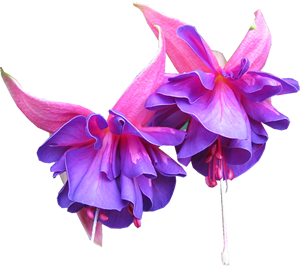
By now all your fuchsias in the garden should be growing well. The most important tasks are continuing to feed and water them. This is especially so with any hanging baskets you may have, as if these do dry out they can be very difficult to water and feed as all the water runs over the sides. The only real cure if this happens is to gently lower them into a bucket of water. Preferably the bucket you use should be just smaller than the basket and as you lower it you can guide those plants hanging over the side of the basket round the bucket so avoiding any damage. If the growth is long raise the bucket by putting it on top of an upside down empty bucket so the growth is not on the ground. Leave it in soak for about haIf an hour or so. This as with all watering is best done in the first haIf of the day. Evening watering should be avoided if at all possible. The reason for this is the fuchsia will become full of water and during the cool of the night will push water out of all its pores including those inside your unopened flowers. The water so produced will mark the blooms before they open. So that when they open they are often covered in brown marks. If the fuchsia must be watered late in the day then only give it a very little so as to just revive it, then water it properly the following morning. If you are one of those technically minded growers who has set up an automatic watering system then please make sure it switches itseIf off at about 4 o’clock.
Another essential task is to continuously remove all the dying blooms complete with seed pods. Scissors are the best tool for this as it leaves a free hand to hold a container to catch the bloom as you cut them off. If the seed pods are left on, the plants will give seed pod development first priority and may then stop producing flowers all together. If their seed pods are removed regularly your fuchsias will continue to bloom.
At this time of the year when the sun can be quite warm plants in pots can be at risk due to the outside of the pot getting very hot. As a large majority of the fuchsias feeding roots are in this area, care is needed. Damage is often greater if black pots are used as these get the hottest. A simple preventive measure is to put the pot the fuchsia is growing in, inside a larger pot and to fill the space between them with peat. This peat will also act as a reservoir for additional moisture when the fuchsia needs it.
One word of caution about watering, if the air temperature around your fuchsias is high the fuchsia will as a defensive measure cause its leaves to go limp, so it looks very similar to one that is dry. If you water plants in this condition when the fuchsia is not taking water from the compost, the compost can become waterlogged and the roots will start to die as they virtually drown. This loss of roots causes the fuchsia to wilt even more, tempting you to water it even more, so even more roots die. So before you water check that the compost is really dry, if it is not, then try moving the fuchsia to a cooler more shaded spot. Where this is not possible then apply water around the ground the fuchsia is standing on.
Fuchsias in pots standing on the ground are a magnet for ants, so most of our potsare slightly raised so the drainage holes are not in contact with the ground. You can buy crock feet for this, but bits of timber do the job just as well. The ants are eaten by not only birds but frogs and hedgehogs as well, so we avoid the use of ant killers, as we do not wish to kill those who feed on the ants.
Fuchsias growing in the ground will at this time of the year be growing very rapidly and beginning to get tall, and before a stonn flattens them, some staking may be necessary. Four bamboo canes pushed into the ground round the fuchsias and then joined together with string will protect them. Please put something on the end of the canes (these are very cheap and well worth using) and do protect your eyes when you bend down. With outside fuchsias the labels often begin to fade during the summer and its well worth rewriting these whilst you can still read them. Its also a good idea to tie the label to the plant rather than just sticking it in the ground. You will have to do this if you dig them up any way so why not do it now.
If you have lots of hardy fuchsias in the garden, the summer may well be the time to consider sowing seed of wallflowers in a separate seed bed, as these can be used to give your hardy fuchsias protection in the winter and will add colour to the border when fuchsias are just dead sticks. The wallflowers can then be planted round the hardy fuchsias in September. By the time you pull up the wallflowers in the spring, your hardy fuchsias will be starting to shoot having had the growth on the wallflowers protecting them from the worst of any late frosts. Fuchsias so protected often come into flower a week or two earlier than those without protection







